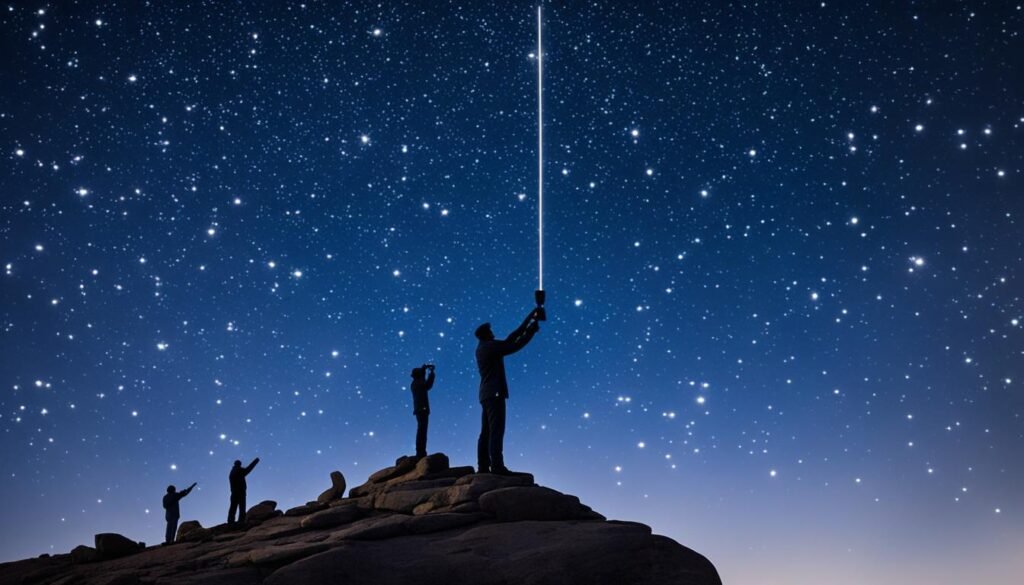| Genitive | Andromedae |
| Abbreviation | And |
| Pronunciation | (an-DROM-ih-duh) |
| Main Stars | 16 |
| Brightest Star | Alpheratz (α And) (2.07m) |
| Right Ascension | 1 hour |
| Declination | 40 deg |
| Sq. Deg. Area | 722 |
| Crosses Meridian | 9 PM, Nov 10 |
| Visible Lat. Range | 90, -40 deg |
Embark on an astronomical journey as you unveil the mysteries of the Constellation Sculptor, a remarkable formation that adorns the southern sky. Originally named “Apparatus Sculptoris” by Nicolas Louis de Lacaille in the 18th century, this constellation has since been known by its shortened moniker, the Sculptor. Despite being relatively faint, with its brightest stars glimmering faintly above third magnitude, it is a treasure trove for celestial aficionados, containing the south galactic pole and fascinating Sculptor Celestial Objects like the Cartwheel Galaxy and the Sculptor Dwarf.
Covering 475 square degrees of celestial real estate, the boundary of Sculptor neighbors constellations including Aquarius, Cetus, Fornax, and Piscis Austrinus. For those of you interested in deep-sky explorations or simply admiring the night sky tapestry, understanding Sculptor Astronomy presents a captivating adventure into the cosmos. The best time to catch a glimpse of this celestial artist’s work is at 9 p.m. during the crisp November nights, ideally situated between latitudes +50° and -90°, where it paints the dark skyline with its stellar brush.
Key Takeaways
- Discover the origins of Sculptor, named by Nicolas Louis de Lacaille in the 18th century, solidifying its place in astronomical history.
- Explore its boundaries with nearby constellations and the significance of hosting the south galactic pole among the cosmos.
- Learn about unique celestial features within Sculptor, including the Cartwheel Galaxy and Sculptor Dwarf, which highlight its deep space intrigue.
- Understand the optimal conditions required for observing the elusive beauty of this constellation, leveraging dark skies for a clearer view.
- Mark your calendars for the best observation period: November at 9 p.m., when Sculptor reveals its stellar scene to the world below.
Unveiling the Sculptor Constellation
Embark on a celestial journey as you explore the remarkable Sculptor Zodiac, a constellation rich with astronomical wonders and deep sky fascinations. By diving into the Constellation Sculptor, you gain insight into the very fabric of our universe—from the notable stars shaping the Sculptor Stellar Design to the magnificent Sculptor Galaxy.
Origins and Location in the Night Sky
The Constellation of Sculptor, originally named “Apparatus Sculptoris”, holds its position firmly in the first quadrant of the southern hemisphere. Encompassing latitudes from +50° to -90°, this constellation, which now bears the brisk name of Sculptor, is situated south of Cetus and Aquarius, marking it as the 36th largest constellation in the night sky.
With the south galactic pole within its bounds, the constellation is a treasure trove of stellar phenomena. Alpha Sculptoris and Gliese 1 are among the brightest stars in this stellar family, guiding your gaze into the depths of Sculptor’s rich star formation regions.
Notable Features and Deep Sky Objects
The deep sky pallete of the Constellation Sculptor is splashed with extraordinary features, including the Sculptor Nebula and an assortment of galaxies. The Sculptor Galaxy, also known as NGC 253, is particularly noted for its intense star-forming activity, ranking as one of the brightest patches visible in the celestial tapestry and a strong radio source.
| Feature | Type | Observation Tips |
|---|---|---|
| Sculptor Galaxy (NGC 253) | Spiral Galaxy | Best viewed with binoculars or small telescopes |
| Cartwheel Galaxy | Lenticular Galaxy | Accessible with large telescopes in dark skies |
| Sculptor Dwarf | Dwarf Galaxy | Identifiable in dark conditions with advanced telescopes |
Accessing Sculptor: Best Time and Conditions for Observation
For those inclined towards Sculptor Astronomy, the constellation is most receptive to your gaze at 9 p.m. in the peak of November. Given that the constellation lacks stars exceeding magnitude 3.00, securing a view under dark skies is pivotal for an optimal observational experience.
Your ability to witness the full spectacle of Sculptor’s nighttime splendor will depend on your location. Observers stationed in the southern hemisphere are privy to a comprehensive view, whereas those up to latitude 50°N can appreciate a partial display. To assist your stargazing journey, employ a constellation map recognized by the IAU and Sky&Telescope magazine, and revel in the beauty of Sculptor’s stellar dance.
Constellation Sculptor: A Historical Perspective
The Sculptor Constellation, a celestial catalogue synonymous with the elocution of the night sky’s artistic intricacies, owes much of its existence to the noted astronomer Nicolas Louis de Lacaille. His 18th-century expedition to the Cape of Good Hope was a monumental journey in the pursuit of expanding heavenly knowledge and mapping the southern stars. During this odyssey, Lacaille bestowed upon this constellation its name—an act lauding the prevailing scientific and artistic renaissance of his age.
Within Sculptor History, it is evident that Lacaille’s desire was not to tie the constellation to ancient myth or lore but instead to anchor it in the rationality and innovation of the Age of Enlightenment. This was indicative of a broader movement in society towards a celebration of human thought and empirical discovery. Below is a comparative table that captures the essence of how Lacaille’s Sculptor Constellation marked a departure from traditional constellation naming conventions.
| Traditional Constellations | Lacaille’s Constellations Including Sculptor |
|---|---|
| Often named after mythological beings or legendary heroes | Named to honor scientific instruments and intellectual progress |
| Carried storied histories connecting them to various civilizations | Reflected contemporary scientific achievements and artistic endeavors of the 18th century |
| Constellations were used to pass down stories and lessons through generations | Intended to promote and reflect the values of the Enlightenment |
As you gaze upon the Sculptor Constellation, you become part of a lineage that transcends the mere act of observation. You engage with a narrative that reflects the human spirit’s relentless quest for knowledge and its desire to immortalize the ingenuity and intellect that constitute our shared history.
Stars of Sculptor: A Cosmic Inventory
As you journey through the stellar tapestry of Constellation Sculptor, you’ll encounter a variety of celestial bodies that contribute to its splendor. Among these, key figures stand out, their characteristics providing a glimpse into the complexities of our universe. Let’s delve into the stellar landmarks of this constellation.

The Luminous Alpha Sculptoris
The pride of Constellation Sculptor, Alpha Sculptoris, shines as its brightest star. This blue-white giant boasts an impressive magnitude of 4.30 and resides at approximately 780 light-years away from Earth. Alpha Sculptoris outshines our Sun by 1,700 folds and exhibits intriguing magnetic field-induced variability, making it an essential beacon for stellar navigation and a critical player in the Sculptor Star Formation narrative.
Exploring the Variability of Beta Sculptoris
Just shy of Alpha’s luminescence, Beta Sculptoris holds its own as a fascinating blue-white subgiant, its light taking about 178 years to reach us. Recognized for its unique Mercury-Manganese star properties and considerable magnetic influence, Beta Sculptoris poses interesting questions about stellar evolution within its star systems. With a radius that doubles that of our Sun and a mass of 3.1 solar weights, its significance in the galactic scheme cannot be overstated.
Discovering Epsilon Sculptoris and Its Companions
Enriching the story of Constellation Sculptor, Epsilon Sculptoris and its companions weave complex relationships across the galaxy. This primary yellow-white subgiant, with a magnitude of 5.29, sits closer to home at just under 90 light-years away. Accompanied by a yellow dwarf and fainter distant stars, its star system embodies the diversified nature of cosmic formations, providing ample opportunities for observation and study.
| Star Name | Magnitude | Distance (Light-years) | Type | Luminosity (Relative to Sun) |
|---|---|---|---|---|
| Alpha Sculptoris | 4.30 | 780 | Blue-white giant (B7 IIIp) | 1,700 |
| Beta Sculptoris | 4.38 | 178 | Blue-white subgiant | Not specified |
| Epsilon Sculptoris | 5.29 | 89.5 | Yellow-white subgiant | Not specified |
As you marvel at these celestial wonders, remember that each star not only illuminates our night sky but also provides critical insights into the formation and characteristics of galaxies. The constellation Sculptor, with its array of stars, acts as a window into the vast universe and the endless possibilities it holds.
Guiding the Way: How to Locate Sculptor in the Sky
Discovering the Sculptor Constellation can be an awe-inspiring experience if you know when and where to look. As a night sky enthusiast, your best opportunity to witness this constellation arrives in November. At precisely 9 p.m., the sky above sets a celestial stage for the Sculptor Celestial Object to emerge with clarity, provided you are positioned away from the glaring city lights.
The visibility for those who reside in the southern hemisphere is spectacular, with the Constellation of Sculptor making a bold statement in the night sky. While for observers north of the equator, the constellation may present a challenge, but with patience and the right conditions, it remains within sight.

Finding the Sculptor Constellation involves identifying specific stellar landmarks. Use these simple steps as your personal guide to locating this somewhat elusive feature of our universe:
- Begin by securing a position with minimal light pollution, preferably on a moonless night.
- Consult a current astronomical chart or app to help position yourself towards the southern sky.
- Look for the bright star Alpha Sculptoris, which acts as a guide to the rest of the constellation.
- Absolute darkness and clear skies are your allies; they will enhance your ability to spot the fainter stars.
- November’s 9 p.m. sky showcases Sculptor in the best light from the southern hemisphere, making it an ideal observation window.
To aid in your stargazing quest, the following comparison chart contrasts the viewing quality of the Sculptor Constellation from various locations:
| Location | Visibility Quality | Best Viewing Time | Recommended Equipment |
|---|---|---|---|
| Southern Hemisphere | Optimal | November, 9 p.m. | Binoculars or Small Telescope |
| Equator | Moderate | November, 9 p.m. | Unaided Eye or Binoculars |
| Northern Hemisphere | Limited | November, Early Night | Telescope |
Remember, spotting the Constellation of Sculptor is a journey, not just a destination. Take your time and enjoy the pursuit of one of the sky’s quiet treasures.
The Hidden Gems: Exploring Sculptor’s Deep Sky Marvels
Within the vast canvas of the night sky, the Sculptor Constellation serves as a celestial museum, holding some of the most remarkable galactic wonders that deepen our understanding of Sculptor Astronomy. The eye of an observer, equipped with even modest telescopic gear, can uncover the treasures nestled in its expanse—relics of cosmic history and cornerstones for current astrophysical research.
Unraveling the Mystery of the Sculptor Galaxy
As you gaze into the realm of Deep Sky Objects, your attention is inevitably drawn to the radiant Sculptor Galaxy. Known as NGC 253, it is one of the brightest galaxies visible from Earth and a proud member of the Sculptor Group. What makes the Sculptor Galaxy such a standout spectacle is not only its luminosity but also its dynamic nature, marked by intense starburst regions that illustrate the vibrant process of star formation. Discovered over two centuries ago, this galaxy continues to intrigue and inspire astrophysicists and amateur stargazers alike.
Deciphering the Structure of the Sculptor Dwarf Galaxies
Alongside the titanic spiral of the Sculptor Galaxy, the constellation harbors the Sculptor Dwarf Galaxies, critical pieces of the cosmic puzzle within the Local Group Galaxies. These galaxies, which include the Sculptor Dwarf Elliptical and the Sculptor Dwarf Irregular, shed light on how galaxies evolve and interact over billions of years. Their unassuming glow belies their significance, as these galaxies provide valuable insights into the dark matter and the early stages of galactic development. Observations and studies of these enigmatic entities are key to unlocking the secrets of our larger cosmic neighborhood.
From Myth to Telescope: Sculptor’s Role in Astronomy
The Sculptor Constellation is a compelling chapter in the annals of celestial mapping, a narrative anchored not in ancient myth but in the very fabric of the cosmos as understood by science. You stand witness to the legacy of Nicolas Louis de Lacaille’s meticulous observations under Southern skies where he etched out constellations that celebrated human ingenuity and scientific progress. Unlike its celestial counterparts rich in mythical tales, Sculptor offers a clear escape as it carries names bestowed by modern astronomers, a testament to its scientific heredity.
Integral to the impressive suite known as the Lacaille Constellations, each celestial body within Sculptor tells a different story of discovery and nomenclature—a story that challenge your perceptions of the night sky. With deep sky observation tools, from telescopes to state-of-the-art facilities like ESO’s ALMA, astronomers peer deeper into the universe, consistently redefining your comprehension of existence. The act of star naming in this constellation goes beyond the romanticism of attaching mythos, reflecting an enduring human quest for knowledge.
Embrace the Sculptor Constellation as a beacon within the discipline of astronomy—a symbol of the transcendence from mere storytelling to exploratory science. From its first documentation to the latest interstellar analysis, Sculptor has been a canvas for cosmic discoveries, charting pathways across the universe’s vast expanse and igniting your curiosity. As you gaze upon its stars, you’re not just recounting celestial myths; you are tracing the edge of human understanding, one star at a time.
FAQ
What is the Sculptor Constellation?
The Sculptor Constellation, known scientifically as “Constellation Sculptor,” is a grouping of stars located in the southern sky. It is recognized for its significant celestial objects, star formations, and importance in the field of astronomy.
Who named the Sculptor Constellation, and when?
Nicolas Louis de Lacaille named the Sculptor Constellation in the 18th century during his work in celestial cartography. He initially called it “Apparatus Sculptoris,” which was later abbreviated to “Sculptor.”
Where can the Sculptor Constellation be found in the night sky?
The Sculptor Constellation is situated in the first quadrant of the southern hemisphere and can be found near the south galactic pole. It is bordered by several other constellations, including Aquarius and Cetus.
When is the best time to observe the Sculptor Constellation?
The optimum observation time for the Sculptor Constellation is at 9 p.m. in the month of November. Observers should be located in areas with minimal light pollution and ideally within latitudes +50° and -90°.
What are some notable features and deep sky objects in the Sculptor Constellation?
Notable objects within the Sculptor Constellation include Alpha and Beta Sculptoris, the bright stars of this celestial assemblage. Deep sky objects include the Sculptor Galaxy (NGC 253), the Cartwheel Galaxy, and the Sculptor Dwarf galaxies.
What are the brightest stars in the Sculptor Constellation?
The brightest stars in the Sculptor Constellation are Alpha Sculptoris, with a magnitude of 4.30, and Beta Sculptoris, shining at 4.38 magnitude. Both are notable for their luminescence and stellar properties.
Is there a mythological story associated with the Sculptor Constellation?
No, unlike many other constellations, the Sculptor Constellation does not have a mythological story linked to it. Its name and the names of its stars are tied to scientific themes and enlightenment, reflecting the period of its naming by Lacaille.
How can I locate the Sculptor Constellation in the sky?
To locate the Sculptor Constellation, use a constellation map and aim to observe during November at around 9 p.m. The constellation is visible from both the southern hemisphere and up to latitude 50°N for those in the northern hemisphere.
What is the Sculptor Galaxy and why is it important?
The Sculptor Galaxy, also known as NGC 253, is a prominent spiral galaxy within the Sculptor Constellation. It is significant for its star formation activity and is part of the Sculptor Group, which lies near our Local Group of galaxies.
What can be learned from the Sculptor Dwarf Galaxies?
The Sculptor Dwarf Galaxies, including the Sculptor Dwarf Spheroidal Galaxy, are elliptical galaxies that belong to our Local Group. They aid astronomers in understanding galactic structures and dynamics, contributing valuable insights into the workings of the universe.







